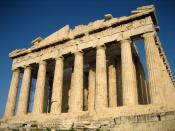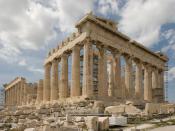Greek Architecture is the most important and influential in Western history reaching a peak between 400 and 300 BC. They developed a new form of architecture that had little to do with function and everything to do with aesthetics and the Athenian way of life. Ancient Athenian Architecture was both diverse and innovative and gives us greater insight into the culture, life style and religion of the ancient Athenians.
Greece was rightly seen as a historic frontier, the root of western architecture. No architecture was more perfect than that of 5th century Athens and this surely was the pure, noble and powerful aesthetics that would best represent the aspirations of the 'new world'. The ancient Greek philosopher Protagoras best described the basis for his civilizations architecture when he stated, "Of all things the measure is man" (Protagoras). From this quote it is evident that Greek culture emphasized the beauty of the human body, and created idealized male and female forms still used today.
A majority of Greek sculpture and architecture includes depictions of the human body, usually to pay respect to a particular god or goddess. The ancient Greeks placed this importance on the human body because the Gods which they worshipped were anthropomorphic, or believed to appear as people. The Greeks believed that each god was flawless, and since the gods took human form, the body which he or she inhabited could be nothing less than aesthetically perfect. This is evident on the temple of Erechtheum that's hosts the famous "porch of the maidens", with six draped female figures (Caryatids) as supporting columns, putting major emphasis of on the female body and the way Athenian women were perceived.
Greek architects developed a very unique pillar system which is called the post and lintel system. They were pretty simple and...


